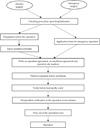Abstract
Purpose
The purpose of this research was to provide patients with safe preoperative preparatory procedures by removing any risk factors from the preparatory procedures by using failure mode and effects analysis, which is a prospective risk-managing tool.
Methods
This was a research design in which before and after conditions of a single group were studied, Failure mode and effects analysis were applied for the preparatory procedures done before operations.
Figures and Tables
Table 1
Scoring System for Severity, Frequency of Occurrence and Detection to Input into Failure Mode and Effects Analysis

References
1. Kim JS, Kim JS. Importance awareness and compliance on patient safety for nurses working in operating rooms. J Korea Acad Ind Coop Soc. 2011; 12(12):5748–5758. DOI: 10.7662/KAIS.2011.12.12.5748.
2. Einav Y, Gopher D, Kara I, Ben-Yosef O, Lawn M, Laufer N, et al. Preoperative briefing in the operating room: Shared cognition, teamwork, and patient safety. Chest. 2010; 137(2):443–449. DOI: 10.1378/chest.08-1732.
3. Christian CK, Gustafson ML, Roth EM, Sheridan TB, Gandhi TK, Dwyer K, et al. A prospective study of patient safety in the operating room. Surgery. 2006; 139:159–173. DOI: 10.1016/j.surg.2005.07.037.
4. Khuri SF, Henderson WG, Daley J, Jonasson O, Jones RS, Campbell DA, et al. The patient safety in surgery study: Background, study design, and patient populations. J Am Coll Surg. 2007; 204:1089–1102. DOI: 10.1016/j.jamcollsurg.2007.03.028.
5. Mehtsun WT, Ibrahim AM, Diener-West M, Pronovost PJ, Makary MA. Surgical never events in the United States. Surgery. 2013; 153:465–472. DOI: 10.1016/j.surg.2012.10.1005.
6. Lee KH, Lee YS, Park HK, Rhu JO, Byun IS. The Influences of the awareness of patient safety culture on safety care activities among operating room nurses. J Korean Clin Nurs Res. 2011; 17(2):204–214.
7. Chiozza ML, Ponzetti C. FMEA: A model for reducing medical errors. Clin Chim Acta. 2009; 404:75–78. DOI: 10.1016/j.cca.2009.03.015.
8. Lu Y, Teng F, Zhou J, Wen A, Bi Y. Failure mode and effect analysis in blood transfusion: A proactive tool to reduce risks. Transfusion. 2013; 53:3080–3087. DOI: 10.1111/trf.12174.
9. Ho CC, Liao CJ. The use of failure mode and effects analysis to construct an effective disposal and prevention mechanism for infectious hospital waste. Waste Manag. 2011; 31(12):2631–2637. DOI: 10.1016/j.wasman.2011.07.011.
10. Bonfant G, Belfanti P, Paternoster G, Gabrielli D, Gaiter AM, Manes M, et al. Clinical risk analysis with failure mode and effect analysis (FMEA) model in a dialysis unit. J Nephrol. 2010; 23(1):111–118.
11. Yang NY, Lee MH. Analysis of effects of chemotherapy using failure mode and effect analysis (FMEA) on patient safety and safe nursing. J Korean Acad Nurs Adm. 2015; 21(3):254–262. DOI: 10.1111/jkana.2015.21.3.254.
12. Reason J. Understanding adverse events: Human factors. Qual Health Care. 1995; 4:80–89.
13. Douketis JD. Perioperative anticoagulation management in patients who are receiving oral anticoagulant therapy: A practical guide for clinicians. Thromb Res. 2002; 108(1):3–13. DOI: 10.1016/S0049-3848(02)00387-0.
14. Dunn AS, Turpie AGG. Perioperative management of patients receiving oral anticoagulants: A systematic review. Arch Intern Med. 2003; 163(8):901–908. DOI: 10.1001/archinte.163.8.901.
15. Chan DTM, Ng SSM, Chong YH, Wong J, Tam YH, Lam YH, et al. Using ‘failure mode and effects analysis’ to design a surgical safety checklist for safer surgery. Surg Pract. 2010; 14:53–60. DOI: 10.1111/j.1744-1633.2010.00494.x.
16. Chun NM. Effective FMEA application for safety improvement in Healthcare Service. J Korea Manag Eng Soc. 2015; 20(4):43–53.
17. Cutter J, Jordan S. The systems approach to error reduction: Factors influencing inoculation injury reporting in the operation theatre. J Nurs Manag. 2013; 21:989–1000. DOI: 10.1111/j.1365.2834.2012.01435.x.




 PDF
PDF ePub
ePub Citation
Citation Print
Print






 XML Download
XML Download